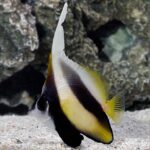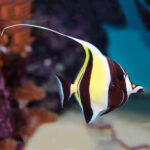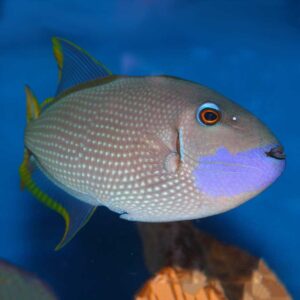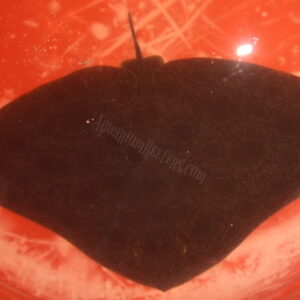Description
The Sunburst Butterfly, scientifically known as Chaetodon kleinii, is a stunning and colourful species. It reaches a maximum size of about 8 inches (20 cm). The body is laterally compressed and oval-shaped, with a prominent snout and small, rounded fins. The base colouration is yellow, with a vibrant burst of orange-red colour on the upper half of the body. The dorsal and anal fins are elongated and adorned with intricate patterns of dark lines and spots, resembling the rays of a sunburst.
Natural Habitat:
The Sunburst Butterfly is commonly found in the warm tropical waters of the Indo-Pacific region. It inhabits coral reefs, lagoons, and outer reef slopes. Its natural habitat is characterized by an abundance of coral formations, including hard and soft corals, as well as a diverse range of marine plants. These fish seek shelter among the corals and rely on them for protection, foraging, and reproduction.
Keeping Sunburst Butterfly Healthy:
The Sunburst Butterfly requires diligent care to ensure its health and well-being. It has a moderate care level and can be moderately difficult to keep. Maintaining stable water parameters is crucial, with a temperature range of 75°F to 82°F (24°C to 28°C) and a pH range of 8.1 to 8.4. Adequate filtration, regular water changes, and a well-established aquarium with live rock are essential for their success.
Special Requirements and Feeding:
Sunburst Butterfly fish have specialized dietary needs. They primarily feed on a variety of small invertebrates and zooplankton found in the reef ecosystem. Offering a varied diet consisting of high-quality marine-based foods such as frozen or live brine shrimp, mysis shrimp, and quality marine flakes is recommended. It is important to provide multiple feedings per day to ensure they receive proper nutrition.
How Many Should I Keep?
It is best to keep Sunburst Butterfly fish singly or in mated pairs due to their territorial nature. They can become aggressive towards conspecifics and other butterflyfish if kept in small tanks. Providing ample swimming space, hiding spots, and territories within the aquarium will help minimize aggression and stress.
Lighting Preference:
Sunburst Butterfly fish thrive under moderate to high lighting conditions. Adequate lighting enhances their vibrant colours and showcases their intricate patterns.
Suitable Tank Mates:
Sunburst Butterflies are generally peaceful but may exhibit territorial behaviour towards similar species. They can coexist with other peaceful reef fish, such as tangs, angelfish, and smaller wrasses. Avoid keeping them with aggressive or highly territorial species that may intimidate or harass them.
Reproduction in the Wild:
In the wild, Sunburst Butterflies engage in courtship rituals before spawning. Pairs perform intricate swimming displays, fin movements, and colour changes to attract mates. Spawning typically occurs near the reef, where the female releases her eggs and the male fertilizes them externally. The eggs then float in the water column until they hatch into larvae, which undergo a pelagic stage before settling on the reef as juveniles.
Breeding Chaetodon kleinii:
Breeding Sunburst Butterfly fish, Chaetodon kleinii, in captivity can be a complex and challenging task. Successful breeding requires careful attention to their specific needs and the replication of natural spawning conditions. Here are some additional details on breeding Sunburst Butterflyfish in captivity:
- Setting Up a Breeding Tank:
To encourage spawning, it is recommended to set up a separate breeding tank that closely resembles the natural reef environment. The tank should have appropriate lighting, live rock for shelter and egg attachment, and a sandy substrate for the female to lay eggs.
- Pairing and Courtship:
Introduce a well-conditioned male and female into the breeding tank. It is crucial to ensure that they are compatible and exhibit natural courtship behaviours. During courtship, the male will display vibrant colours, elaborate fin movements, and engage in intricate swimming displays to attract the female.
- Spawning and Egg Care:
The Sunburst Butterfly typically spawns in the early morning. The female releases her eggs into the water column, and the male fertilizes them externally. It is essential to closely monitor the eggs and ensure suitable water conditions to promote their development.
- Rearing Larvae:
After hatching, the larvae are planktonic and require specific care. They need a well-established culture of copepods and rotifers as their primary food source. The larvae should be transferred to a specialized rearing tank equipped with appropriate filtration and lighting to support their growth and development.
- Feeding and Growth:
As the larvae grow, their diet transitions to larger copepods, enriched Artemia nauplii, and other small live foods. Providing a varied and nutrient-rich diet is crucial for their healthy growth. Maintaining optimal water quality, including temperature and salinity, is essential for their overall well-being.
- Challenges and Considerations:
Breeding Sunburst Butterflyfish in captivity is a complex process and may not always result in success. Factors such as compatibility issues between the pair, inadequate diet, suboptimal water conditions, and the delicate nature of the larvae can pose challenges. Patience, experience, and attention to detail are key in increasing the chances of successful breeding.
Sexual Dimorphism:
There is minimal sexual dimorphism in Sunburst Butterfly fish. Males and females exhibit similar colouration and markings, making it difficult to visually differentiate between the sexes.
Distribution:
The Sunburst Butterflyfish, Chaetodon kleinii, is naturally distributed across the Indo-Pacific region. It can be found in various locations, including the Red Sea, East Africa, the Maldives, Sri Lanka, Thailand, Indonesia, and the Philippines. While captive-bred specimens may be available, the original wild fish primarily originate from these areas.
Summary:
The Sunburst Butterflyfish, scientifically known as Chaetodon kleinii, is a captivating and colourful species that adds a vibrant touch to any marine aquarium. With its distinctive yellow body, orange-red burst of colour, and intricate patterns, it is a true visual delight. While it requires moderate care and specific dietary considerations, providing stable water parameters, a balanced diet, and suitable tank mates can contribute to its overall well-being. Although breeding in captivity is challenging, observing their natural behaviours, and appreciating their beauty make Sunburst Butterflyfish a sought-after addition to reef aquariums.
The Fish pictured here are representative only and the livestock you receive may vary in pattern, coloration, and shape.









Reviews
There are no reviews yet.